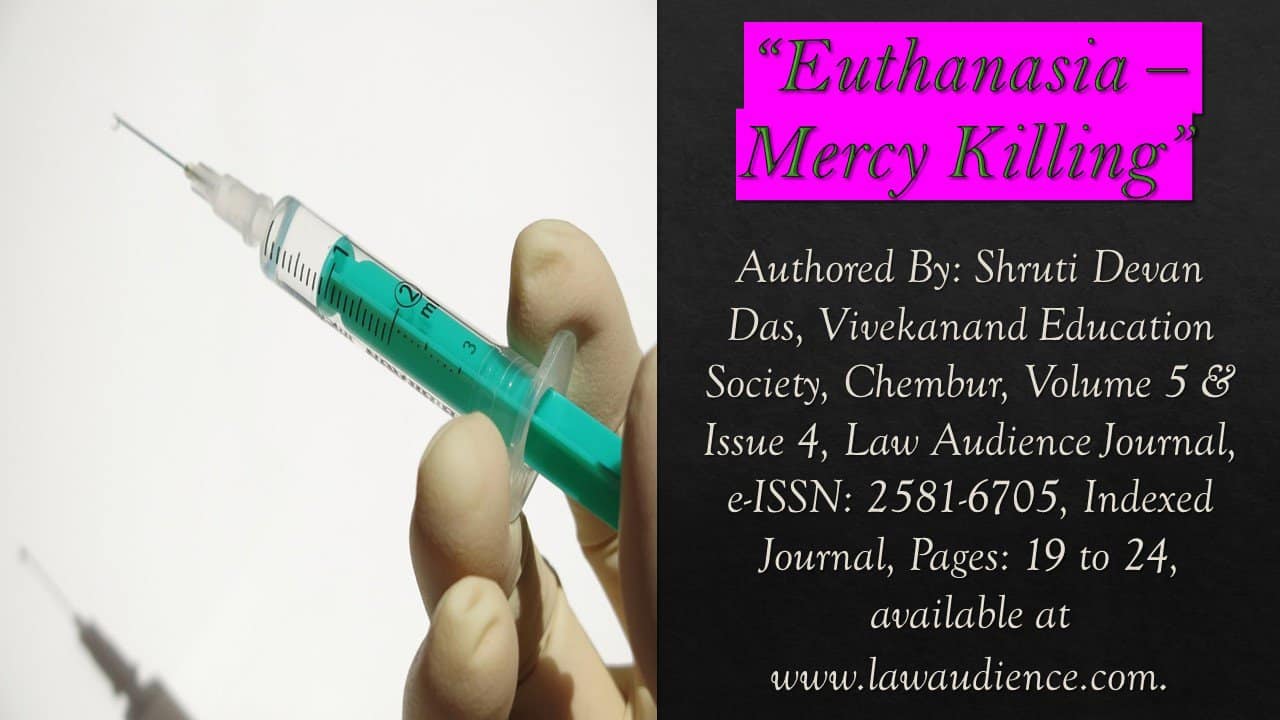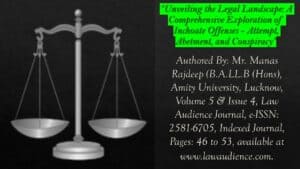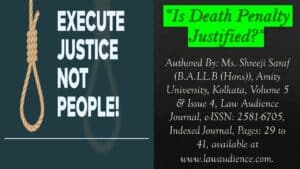Click here to download the full paper (PDF)
Authored By: Shruti Devan Das, Vivekanand Education Society, Chembur,
Click here for Copyright Policy.
ABSTRACT:
“The end of life deserves much more beauty, care, and respect given at the beginning. Euthanasia, they only time when the word “EUTHANASIA” seems easy is when u read but while understanding the concept of “EUTHANASIA” it’s the deepest and the hardest truth of like i.e. respectfully killing a person. The whole concept by itself is a cliche, like how a person can be respectfully killed”.
I. INTRODUCTION:
To explain the concept more let’s understand the word “Euthanasia”; “Eu” means Good, and “Thanatos” means Death therefore, Euthanasia in Ancient Greek means Good Death. Ending a life with the fact that a person in a vegetative stage for a long time cannot be forced to live just for a ray of hope that at least they are breathing even when the medics have got their hands off. Law gives a baffling right to the people that passive Euthanasia is legal. Passive Euthanasia is the most uncomfortable and a very slow method of killing a person just as intentionally killing them by not providing food of drugs they need or even by removing the artificial survival system of which the patient is dependent upon. Opposite to Passive Euthanasia is Active Euthanasia, it is the easiest and simplest way of killing. For instance, injecting a drug which may cause death to the person immediately or after few hours. Active Euthanasia in any form is illegal in India and cannot be legalized. We have always known the fact that every story has 2 sides. Similarly, one side there is no right of a human being to kill any person (or his/her own self) what so ever the case may be even if the person is in a vegetative state or in thoughtful mind. On the other hand, we see the pain and suffering a patient must go through, and the more horrifying situation is when you know that there is no hope of them coming back still, we must see the pain and suffering going on with the patients. The debatable question here is not which side is to choose but rather it’s more like what the law makes the concept of Euthanasia looks like.
II. HISTORY:
It all started when a writ was filed stating the fact of a nurse named Aruna Shanbaug working at King Edward Memorial Hospital, Parel, Mumbai, was attacked on 27th of November,1973 by a sweeper in the hospital. He wrapped Aruna with dog chain around her neck and tried to rape her but she was menstruating so he sodomized her. While doing this act he held the chain very tightly and twisted it too and left her there on the floor. Next morning, on 28th November,1973 a cleaner found the lying on the floor surrounded by blood unconscious. She was immediately admitted. Because of the chain wrapped around her neck was too tight that the supply of oxygen was stopped and her brain got damaged. She also had brain stem contusion injury with associated cervical cord injury. This incident was 36 years ago and now Aruna Shanbaug is around 60 years old. She can’t even move or eat food by herself. Her teeth had decayed. Her body started to shrink and lose the protein and strength to even move her fingers. After 36 years a petition was filed by a friend of Ms. Aruna. Euthanasia is the best case where people get to know that, does Article 21 includes only Right to live or even Right to die. The Intellectual thinking of 2 people is very different, it’s not compulsory that one’s thinking is accepted by all. Even in this case there are arguments and defendant’s viewpoints.
The petitioner’s Argument were very thoughtful and situation based. They argued about the right to life under the Article 21 of the Constitution which states that every individual has right to live his/her life to the fullest and with utmost dignity. And continued that it might also include Right to die with dignity. The petitioner being sensitive and practical states the facts that Aruna must be in deep pain that she is undergoing with, even when there is no chance of her getting back to live a normal and healthy life people are still holding on to her. She had lack of any kind of awareness about what is around her surroundings or people around her or even the food she was eating she was unaware of it. She was not able to express even 1% of her feelings or even move her eyes, she was just bedridden for past 36 years. Being In the position and rather being emotional the petitioner stood for Aruna and asked for death with dignity. The petitioner suggested to allow mercy killing in this case. The patient is bedridden and in a vegetative state so, the respondent, by not feeding her will not be killing her or murdering her. Whereas the defendant, being the Hospital staff and caretaker of Aruna was very dejected and disheartened with the petition filed by the petitioner. The hospital dean argued that Ms. Shanbaug was with them since past 36 years and they are being and taking complete care and responsible about her by feeding, cleaning and other day to day exercises. The nurse there we specifically taking extra care of Ms. Shanbaug. The dean added, with the growing age, death is something natural and her life should naturally be ended and not by some mercy killing methods. The staff are willing to take care of Ms. Shanbaug till her last breath. Therefore, the hospital staff including dean opposed and resented the idea of Ms. Shanbaug being euthanized. They begged the court to not euthanize or kill the patient as the staff are utmost sincere and take full responsibility. If Euthanasia will be legalized then this can be profoundly inclined to abuse and even misuse the real opportunities.
III. ARUNA SHANBAUG CASE DECISION:
The court in the case of Aruna Shanbaug vs Union of India was the benchmark for Euthanasia as through this case court directed the difference between Active and Positive Euthanasia. Active Euthanasia can be seen as the most positive and fast method of terminating one’s life as injecting and administering lethal substances. It is illegal in the whole world unless the orders are given by the legislation himself. And however, a committee of three doctors were formed to thorough examination of patient’s life and state and whether she will have a hope to recover. When the doctors committee gave a report, Supreme court decided with due consent of High Court to end the life of the patient and legalized passive Euthanasia. Passive Euthanasia is only allowed in exceptional and rare cases with full consent of the family member and the doctor in charge for the patient. If any one of the following does not sign or give consent for Passive euthanasia then no passive euthanasia will be performed. Even without the consent of the family members or the doctor if passive euthanasia is performed then that will be considered same as murder under IPC. For this case, the Supreme court said that even though the patient Ms. Aruna was in a vegetative state, but she still is not brain dead and she still had sensations. She could even breath without artificial system for respiration, she could respond her likes and dislikes by blinking eyes or some small gestures.
IV. RIGHT TO DIE vs RIGHT TO DIE WITH DIGNITY:
These two concepts, even if they sound familiar, have a different meaning. Right to die is not included specifically in Article 21 which speaks about Right to live with dignity. This is a very debatable concept, and no explanation or clarification is provided by the constitution. But is Right to die included in the Article 21 or not is more explained in the below landmark cases:
In State of Maharashtra vs Maruti Sripati Dubal, the Bombay High Court states that Right to die is included under Article 21 but later, in case of P. Rathinam vs Union of India, passed the judgement like the above case that Right to not live is recognized and is included in Article 21.
Later, Supreme Court in Gian Kaur vs State of Punjab, overruled the judgement passed in the case of P. Rathinam vs Union of India and Right to die should not be included in in Right to live as right to live is the fundamental right of every citizen and it includes living a life with human dignity. Further, they stated that right to die shall take away a natural life span of an individual and which will cause unnatural death. However, as the difference says, the right to die with dignity will have to follow the process of situations and condition of the patients. Therefore, the Right to die with dignity goes hand in hand with passive euthanasia where such patients should be allowed who are in vegetative state or are brain dead or paralyzed situation or any other incurable disease.
V. SUICIDE & EUTHANASIA:
The main problem nowadays is, with fast pace of life some might not be satisfied with the life they are having and gradually they state that the life given to them is useless and they do not deserve to live anymore and end their lives so easily. This concept is Suicide, the question arises that if passive euthanasia is legal then killing your own self should not be a crime under IPC. To briefly explain Suicide and passive euthanasia is a very different subject, people usually think that passive euthanasia is like suicide. But that is not true. Passive euthanasia is slowly releasing a person with medical issues and rare situation and circumstances and giving them an unnatural. Passive euthanasia is legalized as for the patients with vegetative state or brain dead or such savior cases. Whereas Suicide is not the same, even though it gives people a though of ending their own life but suicide is different. Those who are allowed for Passive euthanasia, such patients cannot come to a normal state or even live a normal life. Whereas, as compared with a suicidal though person they do can come back from such state. Even though at that time people might not find a way to get themselves out if the situation but if calmy found there can be so many solutions emerging to suicidal persons. In suicide cases, there are hopes that the person can change his/her attitude towards life and restart the subject again. But in passive euthanasia everyone around the patient knows that the person in a vegetative state, there is no miracle, no hope that the person can live a normal life. Comparing suicide with passive euthanasia is something very wrong. According to me, the person depressed can try some therapy, or any other ways to recover themselves from getting deep into depression or suicidal thought. Solution is always around but the way you think and understand the situation is very important. If you cannot find a solution at that time wait for the right time rather ending your own life (suicide). The situation of the concept might be same as brain stoppage, no clear thinking, wants to end their own life but the medical state of both the concept is very different. In, Passive euthanasia patients cannot even move or communicate or any other normal human gestures, but as compared this is not the exact situation of a person thinking of ending their own life. Agreeing to the fact that even they might be under mental disturbance and depression.
VI. CONCLUSION:
The history and recent research cases of euthanasia have always been traumatic throughout the human situation. We therefore conclude by saying of course Euthanasia will be a very debatable and differential topic to research upon and to make people understand that just for satisfying their emotional belief they cannot let the other person live in pain. According to be my research and thinking, passive euthanasia should be in the legal system and no law should be passed to abolish this. The concept for passive euthanasia is legalized for rare and special situation and not for all the cases which ask for mercy killing. We should know that there are cases of miracle, and we better understand that such cases which has even one ray of hope that the patient can wake up and live a healthy life should not even be thinking of mercy killing. Secondly, knowing the condition of hospitals and the beds available and even the rate that is cost not everyone can afford. Even if we agree that the medical system has grown rapidly and there are solutions available to rare diseases but the cost of paying for the same is also very high. Death is still going to happen even if we take care of the person or not. If the care if fully taken and still the person dies, the guilt of the caretaker will be more and can be a reason for her depression. Therefore, it is for the betterment of the patient and for the family to accept the government passed law of passive euthanasia.
Cite this article as:
Shruti Devan Das, “Euthanasia – Mercy Killing”, Vol.5 & Issue 4, Law Audience Journal (e-ISSN: 2581-6705), Pages 19 to 24 (26th Jan 2024), available at https://www.lawaudience.com/euthanasia-mercy-killing.



